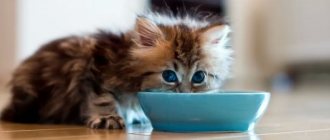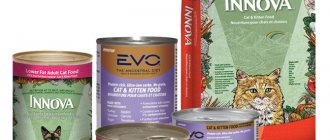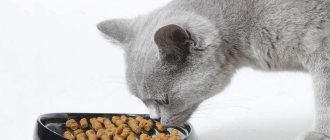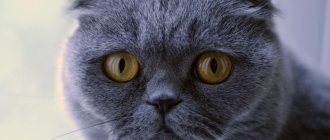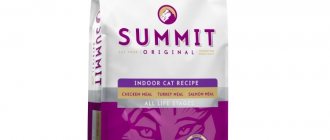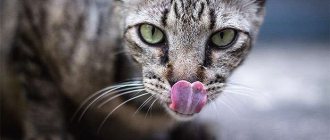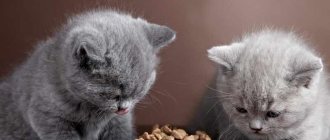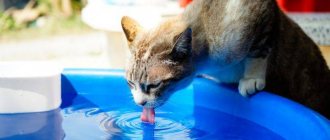Wet food for kittens is a compromise between a natural menu and dry ready-made diets. Most often, canned food and spiders are used as an intermediate when converting to granules, since they cannot be the basis of nutrition. Wet food is more similar in texture to natural food, so it is less likely to cause gastrointestinal problems.
- 2 Types of wet food for kittens
- 3 Classes of wet food for kittens
- 4 What is the difference between wet food for kittens and diets for adult cats?
- 5 Table: overview of popular wet food for kittens
- 6 Reviews from veterinarians about wet food for kittens
- 7 Reviews from pet owners about wet food for kittens
Advantages and disadvantages of wet food for kittens
The key benefit of wet kitten food is that it saves time. Product recipes are prepared by professionals, taking into account all age characteristics and biological needs of animals. The owner just has to open the bag and fill the bowl. When eating natural products, owners have to calculate individual daily norms of nutrients. Ideally, you should take into account the breed, weight, age of the kitten and other characteristics. This forces the owners to update the menu from time to time as the kids grow. The worries don’t end there: you need to buy food and cook food from it. At best, it will be a mixture of meat with offal, which you can stock up on for future use and boil as needed. At worst, you will have to stand at the stove every day. You should also consider the time it will take to find reliable sellers and visit the market and shops.
If the owner is not confident that he is able to create a balanced menu on his own, it is better to use ready-made rations
Using wet food reduces the risk of infection. Natural products may contain viruses, worms and protozoa. You can partially protect yourself if you purchase certified products, but in practice it is either not possible to find sufficiently high-quality meat, or the seller does not have the necessary documents. And the threat of infection remains in any case, albeit minimal. Only those who have their own farm can afford to feed their pet high-quality natural products. In the process of preparing wet food, the ingredients are subject to strict control and heat treatment. Preservatives are used to prevent the development of bacterial colonies. However, it must be taken into account that wet food quickly deteriorates when exposed to air: even when stored in the refrigerator, you will have to get rid of the remains after 24–36 hours. Dry granules are safer in terms of safety.
When feeding natural products and wet food, it is strongly recommended to abandon plastic bowls or change them at least every month: the surface is easily scratched and food particles get into the damaged areas
Wet food is close in consistency to natural products, which makes it an intermediate link between the natural menu and dry diets. Pates and pouches are an ideal option for breeders. With such nutrition, future owners will be able to painlessly transfer kittens to both a natural menu and dry food. Pates can also be used as complementary foods for babies up to 4-6 weeks. The soft consistency prevents harsh effects on the gastrointestinal tract and subsequent inflammation, which often occurs when suddenly switching to granules.
Small kittens should only be given soaked dry food until their bite is formed.
The disadvantages of wet food include their high cost. Even economy class products have a significant impact on the budget. For example, 1 Whiskas pouch costs 20–25 rubles. The manufacturer recommends giving 3-4 sachets per day to older kittens over 3 months old. In fact, this quantity is not always enough: my neighbor feeds his kitten with economy class spiders, following the manufacturer’s recommendations. The pet is very thin and constantly hungry. This can easily be explained by the low nutritional value of economy-class feed. Even if the animal has enough food, the owner will have to spend 60–100 rubles per day. In a month it will cost 1800–3000 rubles for a pet. For the same money you can buy a large (3-5 kg) package of dry holistic, which will last for 6-10 weeks.
It is strongly recommended not to purchase wet food with thick sauces: their production uses thickeners that can irritate the pet’s gastrointestinal tract
Another problem with wet food is its poor composition. If you can add not only meat and offal to the granules, but also a complex of herbs, vegetables and fruits, then in the case of pates the manufacturer is limited by the production technology. This creates a paradox: it is almost impossible to purchase a complete holistic diet, since elite diets should not contain vitamins and minerals in their pure form, and it will not be possible to include many sources of nutrients in the composition. At the same time, almost all economy-class wet food is complete. Manufacturers add vitamin and mineral complexes to them, which are poorly absorbed. As a result, theoretically there seem to be enough nutrients in the diet, but in fact most of them leave the body without being absorbed into the gastrointestinal tract. Because of this, kittens develop a deficiency and develop diseases of internal organs.
Without help, fistula formation, tissue infection and further blood poisoning may occur.
The consistency of wet food is both a plus and a minus. With prolonged feeding of such foods, the baby’s gastrointestinal tract adapts to digest only softened food. In the future, this creates problems when switching to another type of diet. In most cases, digestive disorders occur. Wet food does not contain enough coarse fiber, which causes poor peristalsis. The kitten may have constipation or diarrhea. A friend of mine’s cat’s anal glands became inflamed when she was 9 months old. Normally, they are cleaned with dense feces, but with prolonged diarrhea due to poor nutrition, the secretion accumulates and clogs the pouches. The cat had to clean his glands by hand. Despite nutritional correction, they still periodically become inflamed in the pet. For this reason, even complete wet foods should be combined with dry kibble or natural products.
Feed texture shapes
The first thing that sets wet cat foods apart is texture.
The technology for making canned cat food and dry food has more in common than it might seem.
In both cases, the ingredients are first mixed and crushed, then placed in a special machine, where heat treatment occurs and pieces of certain sizes are formed, after which the pressure and temperature are reduced to obtain canned food, and liquid and related components are added to the contents.
Dry food, on the other hand, is heated until the liquid completely evaporates.
Depending on the texture, all canned cat food is divided into 4 main groups:
- Stew , or whole pieces of meat, fish or seafood - the main ingredients are quite large in shape (in expensive foods, seafood such as mussels or small shrimp may even be present entirely); the binding component can be sauce, broth or a gelling base. Often, in addition to the main protein ingredient, such foods contain a carbohydrate component (grain mixture) and fiber in the form of coarsely chopped pieces of vegetables (carrots, green beans, etc.).
- Chopped meat is a more thorough grinding, in fact it is minced meat with various vitamin supplements, vegetables and grains, it can also be in sauce, jelly or broth.
- Pate - a mixture of components is not just crushed, but thoroughly ground into a homogeneous paste.
- Mousse (soufflé) is essentially the same pate, but with a silkier and more delicate texture, which is achieved due to the fact that the ingredients are also whipped after grinding.
Did you know? Milk can be given to cats up to 6 months old. In adult animals, the enzyme lactase ceases to be produced, and milk can cause stomach upset.
It is impossible to single out the best form of food, since everything depends only on the preferences of the pet and the individual characteristics of its digestive system. For example, mousses and pates are most suitable for kittens, but this is not at all necessary.
When babies begin to feed on their own, they are already quite capable of handling a whole piece of canned meat and do it with great pleasure.
Find out how many times a day and what to feed cats, how to choose the right dry food, the rating of the best holistic treatments for cats, the importance and criteria for choosing vitamins.
In addition, for the little ones there are special forms of food with finer cuts. But if the animal is weakened after illness or due to old age, and chewing food causes him serious inconvenience, pate and soufflé may well be a good way out of the situation.
Classes of wet food for kittens
There is no single official division. Conventionally, there are 4 classes of food: economy, premium, superpremium and holistic. Let's look at each category separately.
Economy class food is the worst among ready-made diets. Cheap raw materials are used in their production. Most often this is waste: feathers, bones, beaks, etc. The proportion of meat is minimal, most of the composition is occupied by water and grains. These foods can only be called nutritious: they contain proteins, fats, carbohydrates, vitamins and minerals, but they are practically not digestible. Kittens should not be given such diets, as they can provoke the development of pathologies.
Economy-class food does not allow the kitten’s gastrointestinal tract to develop normally, which is why it cannot subsequently eat high-quality diets or has difficulty transitioning to them.
Premium food is not much different from budget products. The meat content in them reaches 20% instead of 10%, but this is still not enough. In general, the quality of raw materials leaves much to be desired, but there are some acceptable items. These can be whole chicken carcasses, fish oil or good offal - liver, lung, hearts, etc. However, premium food is also not suitable for regular nutrition.
A distinctive feature of premium food is aggressive advertising, due to which many pet owners mistakenly consider diets in this category to be the best.
Super premium diets are a more acceptable option. Among them there are grain-free pates and pouches. If the composition contains vegetables and fruits, then their variety is indicated. The share of herbal supplements is lower. Manufacturers use high-quality raw materials and specify their type. Super premium feeds do not contain such common names as “bird”, “fish”, etc.
The cost of super premium food often does not exceed the price of premium diets, but in terms of quality the difference is colossal
Holistics are elite diets that contain only the best products. If this is a fish, then it must be raised in the wild. If it's a bird, then it's free-range. No hormones are used in raising animals. Herbal ingredients are minimally processed. The information indicated on the packaging is always true, as confirmed by Roskachestvo research.
Holistic products are almost impossible to purchase in pet stores; they have to be ordered online, but it’s worth it
How to choose the best food for a kitten
First of all, kitten food should be complete. This means that it contains all the necessary vitamins, amino acids and minerals: tocopherol, unsaturated fatty acids omega-3 and omega-6, taurine, methionine, etc. Ideally, they should be presented in their natural form, i.e. as meat, vegetables, fruits and herbal supplements, however, in the production of wet food many ingredients cannot be used. As a result, it is necessary to introduce vitamin-mineral complexes into the composition. If there is a deficiency of nutrients, the kitten may have problems at the stage of development of the musculoskeletal system and the formation of immunity. There is a risk of pathologies of internal organs.
Rickets and deformation of the limbs are the result of a lack of calcium in the menu
It is strongly recommended to avoid feeds that contain dyes, thickeners and sugars. They help give the product a pleasant consistency and color, but for cats these parameters have no meaning. Supplements can be dangerous for pets, especially when they are young. Some dyes can cause irritation to the internal lining of the gastrointestinal tract and urinary system. This leads to blood flow, inflammation and poor digestion.
Manufacturers are forced to add preservatives to keep the food fresh as long as possible. Vitamin E (tocopherol) can act as an antioxidant, but it alone is not enough for reliable preservation. The absence of preservatives in the ingredient list is a warning sign. This may indicate that the manufacturer is trying to hide some information about the composition from the buyer. It is recommended to give preference to wet food whose list of ingredients specifies the type of preservatives. The substance must be safe.
Canned mango pieces are visible to the naked eye; the fruit is used to enrich feed with vitamins and fiber
The presence of grains in wet food is not allowed. They are practically not absorbed by the cat’s body and are used as an inexpensive filler that allows you to save money. A good quality wet food may contain small amounts of vegetables, fruits or beans. They are necessary to improve digestion and normal removal of hair from the gastrointestinal tract. Such ingredients should not be placed above the meat components.
Meat is the basis of the diet of predators. Ideally, animal products are high on the ingredient list. This can be one variety or several, as well as offal. Most often, the composition includes the liver, kidneys, lungs and hearts. These are good sources of cartilage, proteins and vitamins. It is welcome to indicate the specific type of offal and type of meat. It is advisable to avoid feed that contains such generic names as “poultry”, “chicken”, “fish”, etc.
It is advisable to prefer products that contain animal fats. They are better absorbed by cats. Pets also need vegetable oils, because the balance of unsaturated fatty acids in them is different, but their proportion should be lower. The most valuable ingredients for cats are turkey fat and salmon oil.
Denser wet foods prevent indigestion when switching to solid natural foods and dry diets
The choice of consistency depends on the kitten’s preferences. In some cases it is wise to use pate. This applies to animals with difficulty digesting and small kittens (3-5 weeks). Unless you have special needs, it is recommended to choose fibrous pieces that are closest in texture to meat.
What is the difference between wet food for kittens and diets for adult cats?
Wet food for kittens contains more fat and protein, as well as increased concentrations of phosphorus, calcium and magnesium. The difference is due to the characteristics of the body: babies require nutrients for the rapid development of internal organs.
Kitten foods can be dangerous for adult cats. The latter, with poor nutrition, are at risk of developing obesity, diabetes and urolithiasis. Absolutely healthy kittens can eat high-quality wet food for adult cats without negative consequences, but with the slightest deviation from the norm there is a chance of worsening the condition, so experimenting is not recommended. There are universal wet foods that are suitable for both babies and mature animals.
Holistic
Berkley No. 13 “Rabbit and Beef with Zucchini”
The cat food produced by the German company does not contain grains and has a dense texture. Animals chew them before swallowing them, which helps clean their teeth and maintain oral health. These are complete diets that are suitable for daily feeding of adult pets, regardless of breed.
Canned rabbit and beef are enriched with vitamins and microelements. They also contain useful acids - nicotinic and Omega, which normalize cholesterol levels and improve the quality of wool. Zucchini supplies the cat's body with fiber, which stimulates digestion.
Pros:
- completely natural, with a high meat content - beef 51%, rabbit 15% in the total volume of cat food;
- contains folic acid, therefore suitable for pregnant cats;
- helps maintain the health of the genitourinary system;
- easily digestible and does not lead to obesity.
Minuses:
- more expensive than most foods - but in the holistic category one of the most affordable.
Schesir - pauchi with tuna and chicken
The Italian company Schesir produces natural cat food with one of the best compositions. They use chicken and chickens raised without hormones, so the risk of allergies in pets is minimal. Fresh fish and meat, suitable for human nutrition, are steamed and enriched with taurine, vitamins and microelements. Tuna and chicken pouches are suitable for regular and dietary diets and can be given to your pet daily.
Pros:
- There are no by-products, appetite stimulants, dyes or flavors in cat food;
- a large percentage of high-quality protein - 55% tuna and more than 5% chicken;
- Due to its natural smell, consistency and attractive appearance, pets like the food.
Minuses:
- canned food is enriched with vegetable gelatin, which does not contain substances beneficial to cats.
Table: overview of popular wet foods for kittens
| Name of food | Class | Texture and packaging | Kitten age | Compound | Average cost and weight of packaging | Advantages | Flaws | Overall rating |
| Almo Nature Classic Cuisine Kitten | Holistic | Spiders, however, also have food in cans. The pieces are relatively large, but not very dense. The best option for older kittens | 2–12 months |
| 90 rub. for 55 g |
|
| The composition is relatively weak and does not correspond to the inflated price. Rice is supposedly used as a source of fiber, but a healthier ingredient could have been chosen. Bones and shell fragments have been found in food for adult cats, so be careful when purchasing these canned foods! |
| Royal Canin Mother&Babycat | Premium | Mousse in cans | 1–4 months |
| 100 rub. for 200 g |
|
| Despite aggressive advertising, the quality of Royal Canin food is low. Since the manufacturer does not indicate the type of cereal, it can be assumed that the composition includes the most dangerous ones - corn and wheat. They often cause allergies. Most likely, low-quality raw materials are used, since the list of components contains many vague names. The cost of food is very high. |
| Hill's Science Plan Kitten 1st Nutrition Mousse | Premium | Mousse in cans | From 3 weeks to 12 months |
| 70 rub. for 85 g |
|
| Hill's wet food has a mediocre composition, but compared to many popular products, its cost is not so high. However, this is still a premium class, so the presence of the product on the kitten menu is undesirable. |
| Applaws Kitten Tuna | Holistic | Small pieces in a tin can | Not specified by the manufacturer |
| 90 rub. for 70 g |
|
| Wet food cannot be used as the main diet. It is given only as a treat. There is only 0.5% fat in the food, many vitamins are missing, so if you regularly eat canned food, there is a high probability of deterioration in health. Using fish as the main source of protein makes it possible to offer a treat to allergy sufferers. Russian labels indicate that the composition contains a gelling component, although this is not the case in the English version. This is most likely a translation error, since the consistency of the broth is very thin. |
| Leonardo Finest Selection Kitten Poultry | Superpremium | Minced meat in jelly, packed in pouches | From 3 weeks |
| 110 rub. for 85 g |
|
| Although the thickener in the food is natural, it would be better without it, since it does not provide any nutritional value for kittens. |
Approximate feed composition
When choosing food for a kitten, you need to pay attention to its composition. It often turns out that cheap premium food is of better quality than expensive food of a higher category.
The food must contain a protein component. The packaging says something like: chicken, chicken protein, corn gluten. It is necessary to understand that not only chicken meat, but also other parts of the carcass, although well processed, are included in the feed. If the protein component is represented by corn gluten or soy, then it is better to avoid such a product. Vegetable protein is less easily absorbed by the body of a predatory animal, and in addition, such components are quite allergenic.
Carbohydrates in premium foods are usually represented by wheat, rice or corn, and sometimes other cereals.
The composition also includes vitamins necessary for cats (A, D3, E, C, B), micro- and macroelements (manganese, zinc, iron, copper, selenium, iodine), taurine and other useful compounds.
When choosing food, it is necessary to study the composition. Some manufacturers make products based on vegetable protein, which is not very beneficial for cats. You should also pay attention to what substances are used as preservatives and antioxidants. Sometimes the packaging only indicates that such ingredients are contained in the composition. Manufacturers who add natural substances for this purpose that are not harmful to the health of the animal, as a rule, indicate their names (for example, tocopherols).
Also read about the composition of cat food.
Reviews from veterinarians about wet food for kittens
Royal Canin food is made from quality ingredients, but not all ingredients are suitable for feeding cats. The main disadvantage is the presence of plant proteins, which are digested 30% worse than animals. Cereals are responsible for the carbohydrate component, and soybean oil is responsible for the fats. The food turns out to be balanced, but not very healthy, not the most nutritious. The manufacturer solved this problem by adding vitamins, minerals and other beneficial substances. The result is food on which animals feel great and lead an active lifestyle at any age. It is interesting that according to Russian standards the food falls into the premium category, but according to European standards it falls short. It is better to buy food produced abroad. Despite the fact that in Russia they are manufactured under license using good equipment, they are inferior to the original. I would like to draw your attention to the availability of an analogue of cat milk for feeding kittens. In the future, they do not lag behind ordinary kittens in development.
Pavlovskaya Ekaterina Viktorovna
https://otzyvkorm.ru/royal-canin-dlya-koshek/
Hills is the true premium segment. I can’t call it very nutritious, the energy value is average. The specified daily allowance may not be enough; pets feel hungry. However, the food is completely balanced and complete. You can make it the basis of your diet without fear for your health. A significant disadvantage is the overuse of difficult-to-digest carbohydrates.
Pavlovskaya Ekaterina Viktorovna
https://otzyvkorm.ru/hills-dlya-koshek/
"Aplaus" is a VIP-level food, the high quality of which can be judged by the fact that the recipe and manufacturing technology were developed by scientists from the Institute of Nutrition of Great Britain. The manufacturer’s strong point is the absence of cereals and sources of gluten in the feed, both dry and wet. Which causes in animals not only dermatoallergy in the form of dandruff and hair loss, but also swelling and ulceration of the mucous membranes of internal organs. There is no need to write about the assortment, it is wide, there is a diet for all age categories of cats. And not only healthy ones, but also those with problems with digestion and the genitourinary system. The food is optimally balanced and includes a high content of animal products - sources of protein, vitamins, essential amino acids and fiber in sufficient quantities.
Grechany Stanislav Sergeevich
https://otzyvkorm.ru/applaws-dlya-koshek/
Veterinarians' opinion
Experts often differ in their opinions regarding certain foods. Most experts do not recommend feeding kittens with economy-class food at all and advise giving preference to at least premium, and if possible, super-premium classes. Also, when using some economy-class canned goods, a strong smell of feces, inflammation of the anal glands, and digestive tract disorders are noted.
Also, not all kittens are suitable for food from the holistic class. Veterinarians explain this by the development of the gastrointestinal tract and the inability to properly digest whole pieces of meat or fish during adolescence.
When purchasing, veterinarians recommend paying attention not only to the quality of the food, but also to its nutritional value. There are often cases when, with regular economy-class meals, the animal is constantly hungry, despite the good composition of the food in terms of the ratio of proteins, fats and carbohydrates. Cereal components do not provide saturation and are poorly absorbed by the animal’s body, so it is recommended to give preference to feed with the presence of meat rather than proteins of animal and plant origin.
Previous
FoodRating of dry food for kittens
Advantages
At first glance, it may seem that wet food with a balanced composition is much healthier for cats than dry kibble. But in reality this is not always the case. Ready-made canned food has certain advantages and disadvantages. You need to know about them before purchasing food.
There are many benefits to wet cat food.
- Large percentage of liquid. Canned food contains about 75-80% moisture. For animals that don’t particularly like water, this is the best solution that will prevent health problems.
- Diversity. The lines of leading manufacturers include a large number of complete foods and treats in a wide variety of shapes and tastes. They allow you to switch to nutritional therapy without unnecessary stress. Wet foods for sterilized cats are great for post-surgery diets.
- Natural consistency. In high-quality food you can even see the fibers of the meat stated on the packaging. In addition, canned food is the best food for small kittens. During the transition from mother's milk to artificial nutrition, veterinarians advise feeding babies with wet formulas. This way the kitten gets used to feeding on its own much better and faster.
- Convenient dosage. If with natural products it is very difficult to understand what portion to give to a kitten, then the packaging with wet food always contains the necessary information. Usually there is a table with recommended dosage, depending on the weight of the cat.
- Long shelf life. It is ensured by the tightness of the packaging.
As you can see, wet food can come to the rescue in many situations.
Varieties
Like all ready-made formulas, wet cat food is produced in several price segments.
- Economy class Veterinarians around the world categorically prohibit giving such food to pets on an ongoing basis. And all because such mixtures contain a large number of chemical additives, low-quality raw materials and a minimum of meat. Such foods are low in calories, so they only dull the feeling of hunger for a short time.
- Premium class. Such foods have acceptable quality and calorie content, but they often contain various additives, and the composition is not always transparent. In addition, in the premium category there are no medicinal foods intended for cats with health problems.
- Super premium class. Wet food for cats with a high content of proteins and healthy ingredients. There are no harmful additives or by-products in such diets. Such food can be used for the constant nutrition of cats.
- Holistic class. To prepare these feeds, products suitable for human consumption are used. They do not contain harmful components such as dyes and flavor enhancers. Holistic treatments are completely beneficial for pets, which is why they are recommended by veterinarians all over the world.
This classification implies not so much the cost of the mixture as its quality. After all, it often happens that an attractive jar of canned food is very expensive, but its contents certainly do not provide anything useful to the cat. These products usually have bad reviews and low ratings.
Peculiarities
In addition, wet cat food is divided into two more groups.
- Treats. They are not suitable for regular nutrition due to the low amount of amino acids, vitamins and minerals in the recipe. Such food can be purchased only occasionally, in order to give your pet medicine with an unpleasant taste or to simply pamper him.
- Complete nutrition. This category also includes medicinal foods intended for certain groups of cats. Such food is based on a balanced diet, which contains everything necessary for the full functioning of pets: nutritional components, minerals, vitamins, amino acids and other important ingredients.
Wet food is available in various trays, jars, and plastic bags in the form of stew, broth, jelly or sauce. Overall, their variety is truly impressive.
